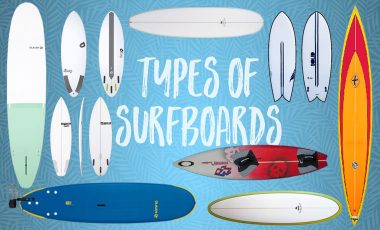Surfboards are the ultimate wave riding machines. They have a huge effect on your experience in the waves and enable you to enjoy a deep connection to the sea in a way that is like nothing else. To truly get the best out of your wave riding experience, it’s crucial that you use the right board for the conditions and for your experience level. But with so many different types of surfboards to choose from, how do you know if you are using the right one?
This guide will answer your questions, whether you are considering what is the best surfboard for beginners or planning on surfing a new type of surfboard. You will find information on all the main types of surfboard and will learn the pros and cons of each. We’ve ordered the types of surfboard according to the level of surfer they are suited to: complete beginner, experienced beginner, intermediate and finally professional. This guide will help you choose the right type of surfboard for you, so the next time you go surfing you’ll be on the perfect surfboard.
- Types of surfboards for beginners
- Types of surfboards for experienced beginners
- Types of surfboards for intermediate surfers
- Types of surfboards for professional surfers
- Other types of surfboards
Types of surfboards for beginners
Foamie Surfboard
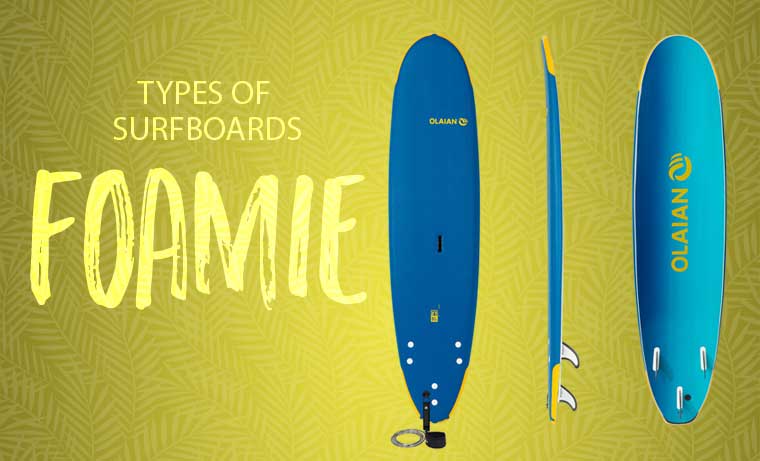
Best conditions: 1 – 5 ft waves
Board length: 5 – 10 ft
Number of fins: 1, 3
The foamie longboard is without doubt the best type of surfboard for beginners. In fact, every surf school uses them for some very good reasons. Foamie surfboards are wide, full of buoyancy and have thick forgiving rails. They are also almost indestructible and are made from a softer material than other types of surfboard. As a result, they are easy to catch waves on and most importantly are very stable. Furthermore, they are less painful in a wipe-out and can withstand any accidental knocks and dings. If you learn to surf on a foamie surfboard you will get to your feet in no time.
Pros
- Soft
- Durable
- Very Stable
- Will catch even the smallest waves
- Best surfboard for beginners
Cons
- Heavy
- Hard to manoeuvre
- Large size
Types of surfboards for experienced beginners
Mini Mal Surfboard
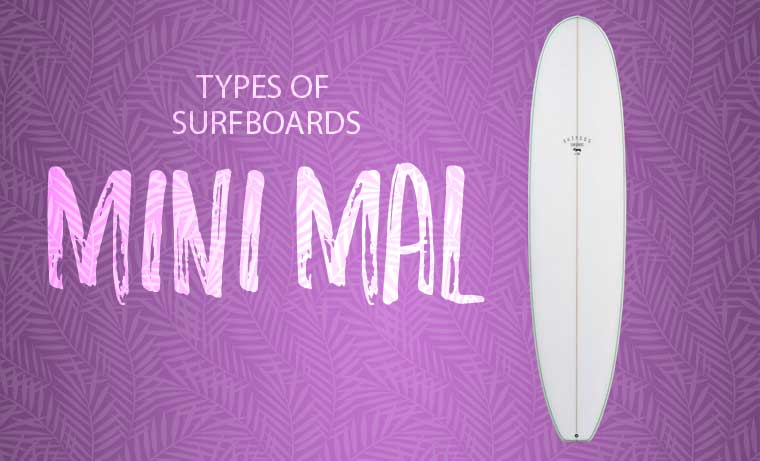
Best conditions: 2-6 ft waves
Board length: 7 ft – 8 ft
Number of fins: 1, 3
Mini mals are often referred to as “mid-lengths” because they are shaped like short longboards. They are a great type of surfboard for beginners, especially if you are looking to improve your longboarding skills. This is due to the shape of mini mal surfboards. Firstly, they are wide with a flat rocker and rounded nose. This helps with stability and paddling speed, so you will catch more waves in a session. Secondly, as they are smaller than longboards, they are more manoeuvrable and easier to control in the waves. Finally, they have lots of volume in their nose, so you can learn to walk up the board and nose-ride. Therefore, surfing a mini mal surfboard will teach you the techniques needed to surf a longer board and a mini mal surfboard, surfed well, is almost always the most stylish board in the water!
Pros
- Easy to catch waves on
- Stable
- Teaches you the techniques needed for longboarding
- More manoeuvrable than a longboard
- Can be used in good and bad conditions
Cons
- Less manoeuvrable than smaller boards
- Large size
Hybrid Surfboard

Best conditions: 2 – 6 ft waves
Board length: 6 – 8 ft
Number of fins: 3
There are many types of surfboard for beginners and improving beginners. Another another great option is a hybrid surfboard. Hybrid surfboards are a cross between a longboard and a shortboard, and as a result have a wide and rounded shape.
These surfboards are often called funboards because their large volume means they are great at catching waves and they are great fun to surf! Surfing a hybrid surfboard is the next step for any beginner wanting to progress to shorter hard boards. Not only are they long enough to easily catch waves and wide enough for good stability, but they are also more manoeuvrable than a foamie surfboard. Therefore, they are the best surfboard for beginners looking to improve their turns and for getting used to surfing a shorter board.
Pros
- Stable
- More manoeuvrable than a foamie surfboard
- Easy to catch waves on
- Can be used in a range of conditions from good to bad
Cons
- Harder to paddle and less stable than a foamie surfboard
- Not as manoeuvrable as smaller boards
Longboard
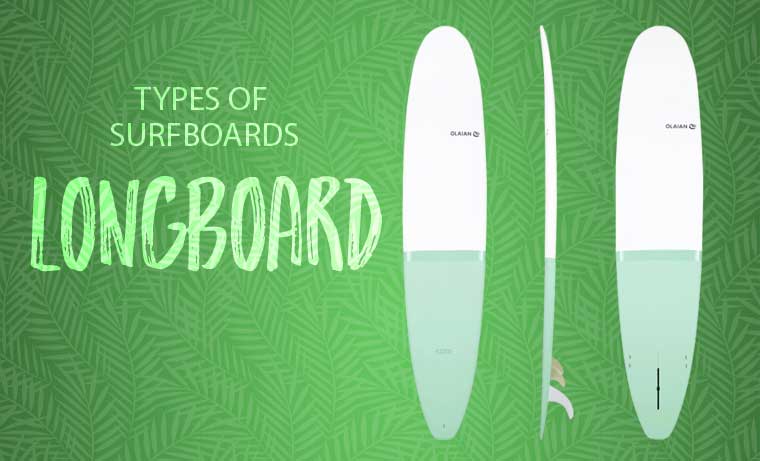
Best conditions: 1 – 10 ft waves
Board length: 8 ft 6 inches – 10+ ft
Number of fins: 1, 3
Longboard surfboards are the original wave riding craft. They are the forerunner for all the other types of surfboard and as the name suggests, longboards are long! A typical longboard will be over 8 ft 6 inches long and will have a wide shape with a rounded nose and pin or square tail.
Their unique shape means they have specific characteristics that have defined the art of longboarding. Firstly, they have a lot of volume. This makes longboards wave catching machines and allows you to walk up the board. Secondly, they normally have a wide nose with lots of buoyancy. This means with a bit of practise you can hang ten toes over the front of your board without wiping out. Hanging ten is one of the most stylish moves in surfing and you can only do it on a longboard. Finally, and most importantly, longboards are large and large surfboards are generally harder to turn. Therefore, longboarders have developed a cruising, graceful style where they flow with the wave rather than against it.
Longboard surfboards make great beginner boards as they are very stable and will catch any wave. For intermediates, longboards let you glide over the waves and offer the chance to experience the joys of hanging ten.
Pros
- Will catch any wave
- Lots of volume so can walk up the board
- Paddles easily
- Great for cruising
Cons
- Large
- Can be hard to manoeuvre
- Heavy
- Difficult to get through whitewater
Types of surfboards for intermediate surfers
Egg Surfboard
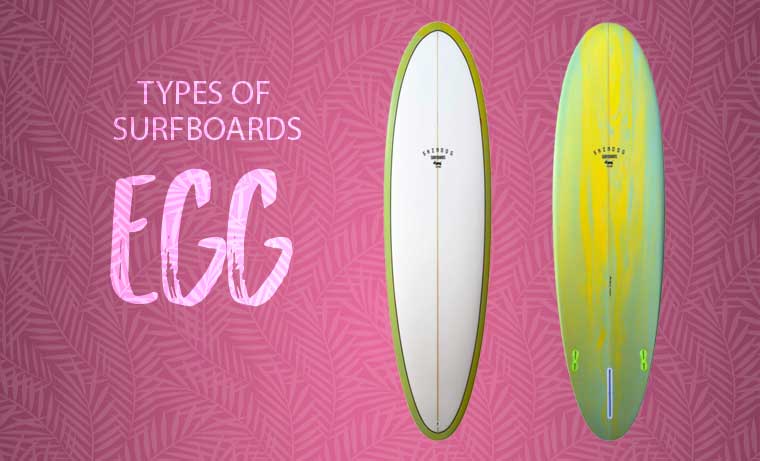
Best conditions: 2 – 6 ft waves
Board length: 6 ft 5 inches – 8 ft
Number of fins: 1, 3
An egg surfboard is a type of hybrid surfboard. Like other hybrid surfboards they have a wide shape and forgiving rounded rails. Their name is due to their squished length and unique oval shape, giving them the appearance that is somewhat like an egg!
Egg surfboards are great surfboards for intermediates looking to surf shorter boards. This is because their width means you can surf a shorter length than usual without compromising on volume. Whatever your reason for surfing an egg surfboard, they are wonderful boards, and you are sure to have a lot of fun in the water.
Pros
- Wide width means lots of volume so you can surf a shorter board than normal
- Manoeuvrable
- Easy to catch waves on
- Surfs well even in bad conditions
Cons
- Large size
- Not good for larger waves
- Hard to duckdive
Fish surfboard

Best conditions: 2 – 6 ft waves
Board length: 5 ft 2 inches – 8 ft
Number of fins: 2, 4
Fish surfboards are named after their wide split tails that slightly resemble the outline of a fish. This type of tail can also be called a swallow tail or fish tail and any surfboard with this tail can be called a fish surfboard.
Most fish surfboards are short and thick with a wide nose and little rocker. They paddle fast and are great for catching low quality waves. In addition, their short length means they are easy to manoeuvre, and their design means fish surfboards are incredibly fast. This means they can flow over any flat sections and let you make the most of the wave.
Fish surfboards are great for intermediate surfers looking to develop their turns and manoeuvres on a shorter board. Moreover, because they are great at catching waves you will be able to surf more and progress faster. Fish surfboards are also perfect for the days when the quality of the waves is less good, and they are great fun in small crumbly surf.
Pros
- Paddles fast and will catch waves easily
- Good for mushy days
- Manoeuvrable
- Can duckdive
- Fast
Cons
- Lack of rocker means they are less good in hollow surf
- Harder to control in larger waves
Shortboard

Best conditions: 3 – 12 ft waves
Board length: 5 – 7 ft
Number of fins: 3, 4, 5
The name shortboard can be applied to a huge range of surfboards. The defining characteristics of shortboards are that they are short(!) and have narrow pointy noses. Besides this, shortboards can have many different types of tail, varying degrees of rocker and different volumes, all depending on the needs of the surfer. Typically, shortboards are low volume and are designed for maximum performance.
Out of all the types of surfboards, shortboards are the most manoeuvrable. This makes them the perfect surfboard for intermediate surfers looking to develop their turns and try new tricks. Shortboards are also the go-to surfboard for barrel riding. However, due to their low volume and pointy nose they are not suitable for beginners.
Pros
- Small and lightweight
- Can duckdive
- Very manoeuvrable
- Good for powerful waves
Cons
- Not stable
- Hard to paddle
- Pointy nose
- Delicate
Types of surfboards for professional surfers
Big Wave Board
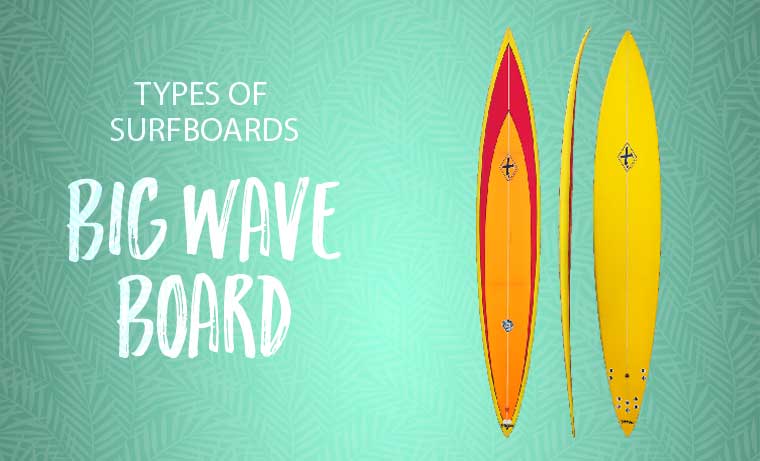
Best conditions: 15+ ft waves
Board length: 7 – 10+ ft
Number of fins: 3, 4
A small amount of people enjoy surfing very large waves. If you happen to be one of these people, then there are two types of surfboard for you. The first is a big wave board. Big waves move extremely fast, so to catch them, big wave boards have been designed to paddle very quickly. They are long and narrow with a pointy nose and tail. In addition, they are thick and much heavier than normal surfboards. This helps the surfer catch and negotiate the drop into the wave. Most of us will never surf a big wave board, but for those that are brave enough, big wave boards help them surf some of the largest waves in the world.
Pros
- Can surf huge waves
Cons
- Only good for huge waves
Tow-in Board
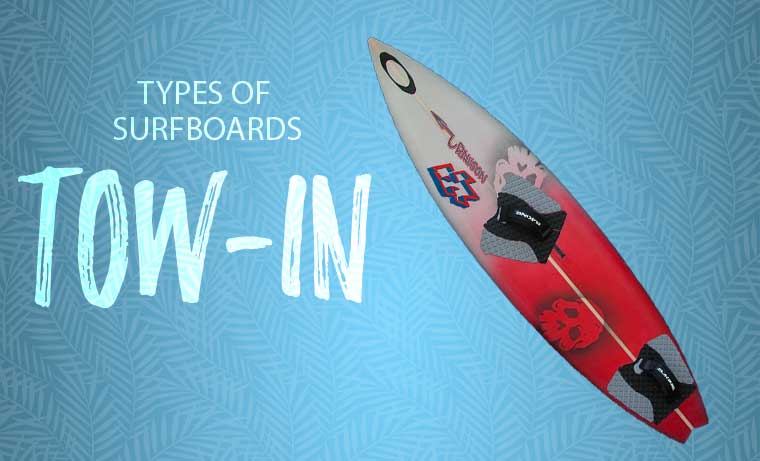
Best conditions: 15+ ft waves
Board length: 5 ft 5 inches – 6ft 2 inches
Number of fins: 3, 4
Big waves move fast. In fact, some waves move so fast that you cannot paddle into them using arm power alone. To solve this problem tow surfing was created. Surfers are towed into waves behind a jetski and therefore are moving fast enough to catch the wave.
Tow-in boards are short and often have foot straps making them highly manoeuvrable. They are also very heavy which helps them cut through any bumps on the wave face. Tow-in boards are used by surfers to catch any wave that can’t be paddled into, and because of this they are used to surf the largest waves on the planet.
Pros
- Can surf huge waves
Cons
- Need a friend with a jet ski
Other types of surfboards
SUP Surfboard
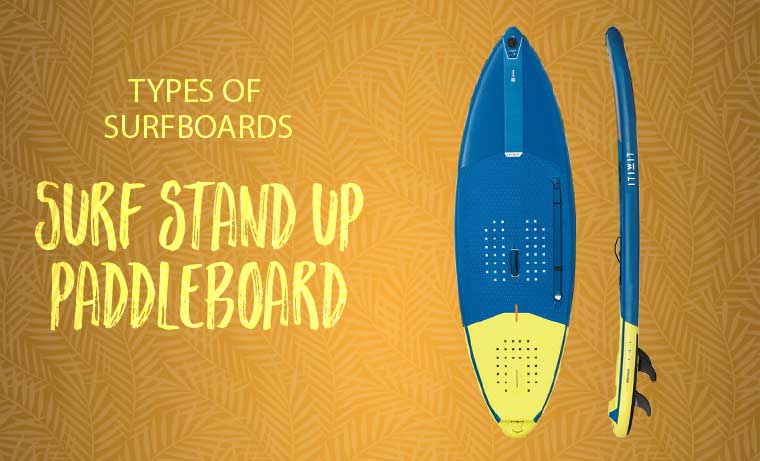
Best conditions: Any, depending on the type of surfing paddle board (not big waves!)
Board length: 7 – 12 ft
Number of fins: 1, 3
It is worth mentioning another form of wave craft, the SUP surfboard. SUP surfing is the art of riding a paddle board on a wave. Just like surfboards, the shape and style of surfing paddle boards vary depending on conditions and the level of the SUP surfer.
Paddleboards for surfing have more volume than surfboards and start at around 7ft in length. Shorter surfing paddle boards are more manoeuvrable and are better suited to experienced SUP surfers. Whereas, longer surfing paddle boards are used by SUP surfers looking to cruise like a longboarder.
Pros
- Already standing when you catch the wave
- Good at catching waves
- Can use paddle to help you turn
Cons
- Large board
- Hard to paddle through whitewater
As well as the above main types of surfboards, there are variations and adaptations of them all that can be custom made to suit you and your riding style. They’re all out there just waiting to be surfed, so grab the right one for you and have a wonderful time in the waves!


